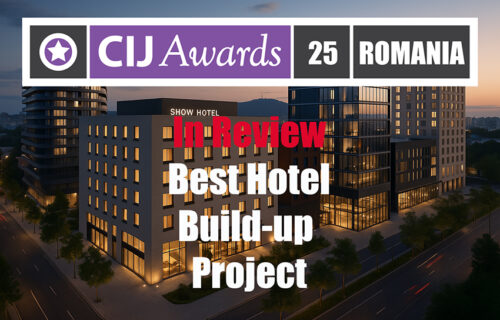Romania’s hotel investment market has shifted into a phase defined by brand consolidation, mixed-use integration and the repositioning of landmark sites. This year’s CIJ Awards Romania 2025 nominees in the category Best Hotel Build-Up Project of the Year showcase developments that are not merely adding rooms to the country’s capacity but reshaping the hospitality landscape through international operators, new service models and destination-driven concepts. Across all projects, three elements determine performance and risk exposure: market demand and feasibility, financial strength and cost discipline, and the ability to deliver and operate at an international standard after opening.
The entry of Hyatt into Bucharest through Hyatt Place & Hyatt House, part of the wider Nusco City regeneration, is a strategic response to demand created by new corporate tenants and high office density in the northern business district. The mixed-use context directly supports feasibility: retail, residential and offices feed demand throughout the week, reducing reliance on seasonal peaks. By securing two complementary brands under one roof—one aimed at short-stay corporate travellers, the other at extended-stay guests—the project broadens its revenue profile and stabilises occupancy throughout the year. The investment commitment exceeds tens of millions of euro, signalling strong balance-sheet capacity from the developer, while the location within a growing urban district supports long-term asset resilience. From an operational risk perspective, the main challenge will be synchronising hospitality operations with a multi-phase district still under development, though affiliation with an experienced global operator mitigates the learning curve.
On the coast, Radisson Blu Hotel & Residences Mamaia tackles a different market challenge: seasonality. The northern edge of Mamaia has traditionally suffered from fragmented development, short tourist cycles and limited all-year operations. By introducing a premium, internationally recognised brand with a wide suite of amenities—spa, wellness, upscale dining and event spaces—the developer aims to shift the local business model from a ninety-day peak season to year-round monetisation. Financial feasibility depends on achieving premium rates and attracting off-season corporate and leisure events. The capital allocation is significant, and the return model will rely heavily on the property becoming the beach destination of choice, not just another hotel. The developer’s strategy, emphasising quality and service rather than speculative volume, suggests that the business case is driven less by unit sales and more by recurring hotel performance.
Further south, Rivaz Hotel Olimp, developed by the Alpin Group, focuses on lifestyle hospitality and premium leisure experiences. Unlike the Radisson Blu, Rivaz positions itself as a signature property within the developer’s expanding portfolio, and the group is financing the concept largely through internal resources and reinvested earnings from existing operations. This lowers exposure to external financing volatility and demonstrates confidence in the long-term performance of the coast. Amenities include a rooftop infinity pool, spa and private beach access, creating a resort model that commands high room rates and diversifies revenue across food, beverage and wellness. The operational plan benefits from the developer’s existing experience running one of Romania’s largest mountain resorts. The main risk lies in market over-reliance on premium domestic tourism; however, if the developer succeeds in positioning Olimp as a leisure destination rather than a summer-only alternative, Rivaz could help reset the narrative of the Romanian coastline.
Back in the capital, The Julius Bucharest is the most complex project from a risk and execution perspective. It involves the transformation of a historic building—formerly the Ambasador Hotel—into a contemporary hospitality destination. Heritage redevelopment heightens the risks: unforeseen structural requirements, heritage approvals and cost overruns are common in projects that involve both preservation and new systems installation. However, the reward is structurally different from new construction. A repositioned landmark brings instant brand equity, and hotels placed in cultural urban arteries typically outperform in occupancy and rate, particularly when supported by strong retail or café activation at the ground floor. The developer’s partner, a specialist project management company, reduces execution risk by integrating design, permitting and construction oversight within one coordinated process, which is crucial given the technical and financial sensitivities of restoring a protected façade. The feasibility here relies not just on room revenue, but also on capturing local spending through cafés, restaurants and event spaces—a hospitality model built equally on community and tourism.
Taken together, these nominations show a hotel sector investing not just in capacity, but in identity. Each project selects a distinct strategy. Nusco City leverages corporate density and mixed-use synergies. Radisson Blu Mamaia seeks to lead a regional transformation at the seaside. Rivaz Olimp introduces the lifestyle resort model to an area in need of reinvention. The Julius Bucharest uses heritage as an asset to attract both guests and locals.
Financial viability across the category is strengthened by the presence of experienced developers with access to financing and, in three cases, international hotel brands known for disciplined operating models and centralised distribution. Operational risks vary: mixed-use integration requires careful phasing, seaside resorts depend on market repositioning, and heritage redevelopment demands precise execution. But all projects share a clear and confident thesis. Demand exists, capital is committed and the operational frameworks are serious enough to sustain performance past opening night.
These developments are not simply new hotels. They signal a market that is finally valuing hospitality as an urban infrastructure asset—an anchor for neighbourhood identity, tourism growth and long-term return on investment.
Source: CIJ EUROPE Analysis Team © 2025 cij.world
